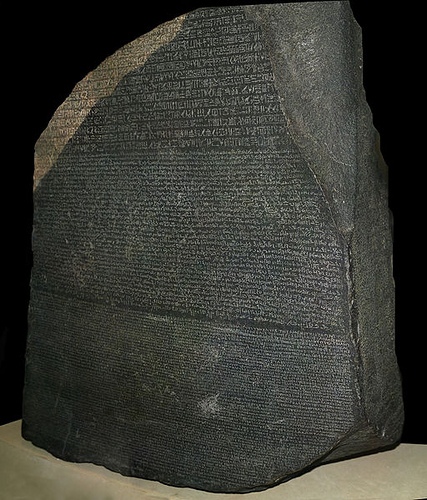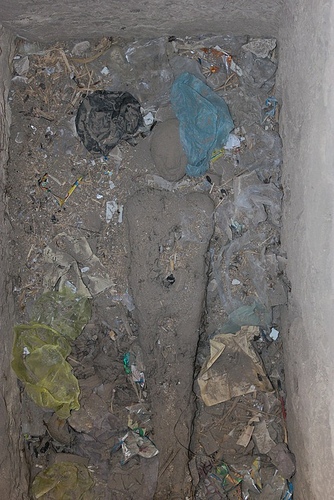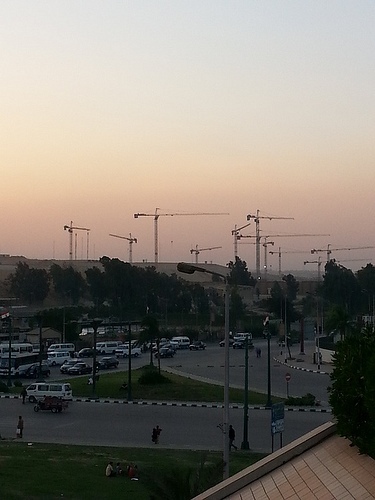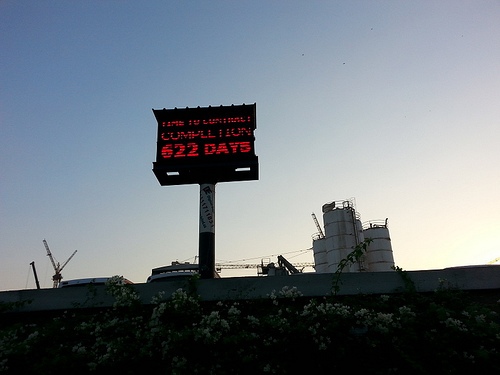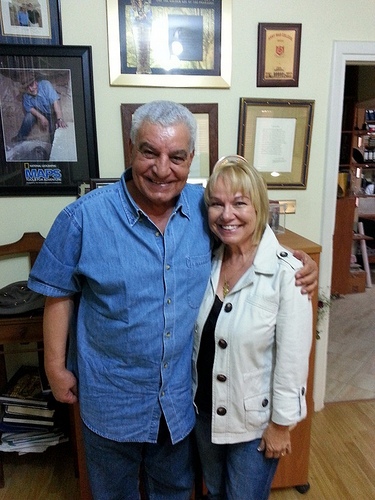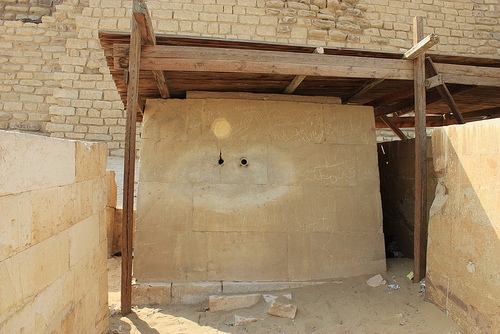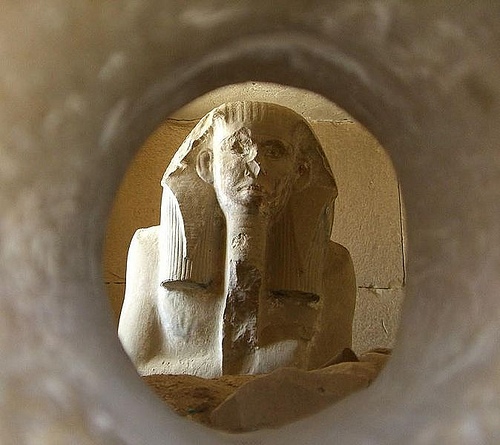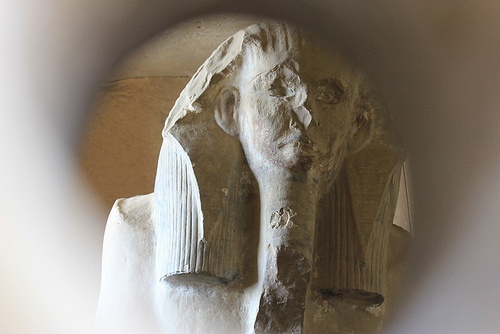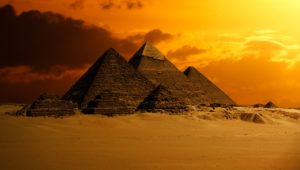
Editor’s Note: The following article is a ‘blast from the past’ re-publication of the original article, published in 2013 at Popular Archaeology. It was subsequently removed from access, but is now re-published as there are many new readers who would not otherwise have had the opportunity to read the story, and recent efforts to negotiate the return of the famous bust of Nefertiti to Egypt from Germany has been championed by this subject article’s Dr. Zahi Hawass . Much has changed in Egypt and with Dr. Zahi Hawass since the interview was conducted, in terms of both the political situation in Egypt and the research and discoveries he has made since that time, so readers should bear this in mind. Although he may remain a somewhat controversial figure in some circles, he nonetheless has played a prominent role historically in the ongoing narrative on discovering Egypt’s past. Since the interview, he has made notable contributions to Egyptology, including unearthing the tombs of the pyramid builders at Giza and the Valley of the Golden Mummies at Bahariya; and through the Egyptian Mummy project, he led efforts to conduct CT scans of the mummy of King Tutankhamun and other important figures such as Queen Hatshepsut and Nefertiti to learn more about their lives and deaths. He continues to be a strong, leading advocate for the protection, repatriation and conservation of Egypt’s antiquities.
Cairo, Egypt – It took over an hour navigating through chaotic Cairo traffic to arrive at Zahi Hawass’s apartment building. Nestled amidst a bustling suburb, it was a surprisingly austere place for a man who, it seemed but moments ago, held Egypt’s highest post for the management of its antiquities and, for years, was Egypt’s iconic face to the world when it came to antiquities. As we entered the dusty and dimly lit lobby, the guard stoically nodded for us to pass to the elevators that would take us up to Zahi’s apartment. Once we arrived, his assistant opened the door and politely greeted us, asking us to come in. His office had an academic air and was well kept, much like a professor’s office. The walls were filled to capacity with books about Egyptian archaeology, many of them authored by Zahi himself, who has produced numerous titles on Egyptology over the years. There were clusters of framed photos, and certificates of appreciation and accolades given to him over the years from schools, universities and governmental agencies, among others. Life in this space has become much quieter since before the revolution. Back then, he’d usually have teams of student assistants swirling about, helping to coordinate and organize his ambitious workload. With so many projects being managed at any given time, he needed all the help he could get. No longer.
Zahi met us warmly with an infectious, friendly smile. It was no wonder. I was with his longtime friend Mary Lomando. She met Zahi over 20 years ago, while she was completing her degree as an Egyptologist. Today, she is a seasoned tour leader and owner of PachaTera Travel. For Zahi, she was a welcome face, and for good reason. He has grown weary of being maligned by the media and his countrymen because he had been a cabinet appointee of deposed President Hosni Mubarak.
So it came as no surprise that, as we sat down together and began our discussion, one of the first topics naturally related to how recent events in Egypt had affected Zahi’s image. From his perspective, the people of Egypt found him an easy target, and he inevitably became a scapegoat for their frustration with anything to do with Mubarak’s regime. Even though all of the charges of corruption against him have since been dropped due to lack of evidence, some still try to malign his work. But love him or hate him, the facts speak clearly: he has arguably done more for restoring the sites of Egypt, preserving its antiquities, and announcing new discoveries, than any other archaeologist in recent history. He has written or co-written more than 60 books on Egyptian archaeology, containing new insights and discoveries. Through his books and public speaking events, he has educated and informed countless archaeologists and archaeologists-in-training, reinforcing the notion that it’s not about the gold, but the ‘treasure’ of information gleaned from the artifacts that tell the “story of us.” In Zahi’s words, “If anyone were to ask what my religion is, I would answer my religion is to train other archaeologists to be better archaeologists than I was!”
Despite his celebrity status, Zahi sees himself not as a media personality, but as a guardian of Egypt’s rich heritage. At the start of the revolution in January, 2011, Zahi took a big risk by forming a human chain with other Egyptians in the streets in front of the Egyptian Museum in Cairo, hoping to prevent protesters from storming the museum. This act was not reported by any media source. While in his post with the Egyptian government, he was responsible for repatriating over 5,000 artifacts from museums all over the world. The New York Metropolitan Museum cooperated with him in returning 19 artifacts from King Tutankhamun’s tomb. His boldest move was more controversial: for the first time in history, he blocked France from digging at Saqqara until the Louvre returned the five fragments of the Tetiky frescoes taken from the West Bank in Luxor. Said Zahi, “a bomb dropped at the Louvre when I stopped the French from digging at Saqqara.” His bravado worked and all frescoes were returned.
“What are the most important artifacts you feel should be returned to their home in Egypt?” I asked.
He spouted off a short list of the most significant, such as the Statue of Ramses II in Turin, Italy; the statue of the architect, Hemiunu of the Great Pyramid at the Roemer-und Pelizaeus-Museum, Hildesheim; the bust of Prince Ankhhaf at the Museum of Fine Arts in Boston; the Dendera zodiac at the Louvre in France; the Rosetta Stone in the British Museum; and, of course, the famed bust of Nefertiti in the Berlin Neues Museum.
Regarding the Nefertiti bust, said Zahi: “There is no progress after years of stalled negotiations and the new Minister of the Supreme Council for Antiquities has sadly and unbelievably publicly declared he does not want Nefertiti returned to Egypt.”
_________________________________________________________________________________________
The Rosetta Stone as exhibited in the British Museum. Hans Hillewaert, Wikimedia Commons, Creative Commons Attribution-Share Alike 4.0 International license.
_________________________________________________________________________________________
I asked him how he felt about the overall difference he has made for Egypt in meeting its objectives related to its antiquities. He recounted some of the projects and achievements for which he was instrumental during his tenure before the revolution:
- The initiation or establishment of 24 new museums around the country. Six have been completed. The rest are still under construction;
- The complete restoration of the Serapeum and reinforcement of the Step Pyramid at Saqqara;
- Excavation of Pharaoh Seti’s tomb tunnel;
- Renovation of the conservation lab at the Egyptian Museum;
- Extension of the Luxor Museum; and
- Restoration of the Sphinx and its enclosure.
_________________________________________________________________________________________
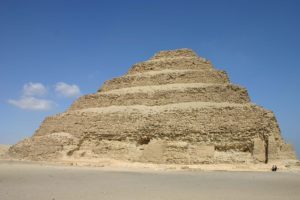
The Step Pyramid at Saqqara. Wikimedia Commons, Public Domain
_________________________________________________________________________________________
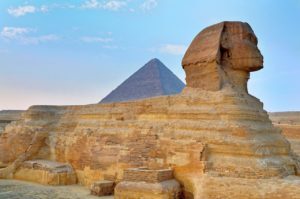
The Great Sphinx, as seen today. Makalu, Pixabay
_________________________________________________________________________________________
As would be expected, discussion gravitated to the impact of Egypt’s slow-boil revolution on its priceless antiquities, in and out of the ground. The archaeological sites of Egypt are unbelievably empty of tourists — one of the casualties of the civil unrest. Security has much to do with this. The monuments, exemplifying some of humanity’s greatest achievements, are barely guarded, and in some sites there are no guards whatsoever. Many sites are in a neglected condition, littered with animal dung, graffiti, and trash.
Moreover, the wave of Islamic extremist incidents throughout the country, fueled by the Muslim Brotherhood, haven’t helped matters. One cleric recently threatened to dismantle the Pyramids and ancient temples. It seems that Islamic fundamentalism isn’t friendly to secular archaeology, which highlights the accomplishments of ancient people with a different belief system, even though today’s Egyptians generally no longer subscribe to it. And looting, like a viral disease, is running in epidemic proportions.
“The current situation is a disaster for Egypt,” said Zahi, “and particularly in Abu Sir, there are illegal excavations everywhere!”
_________________________________________________________________________________________
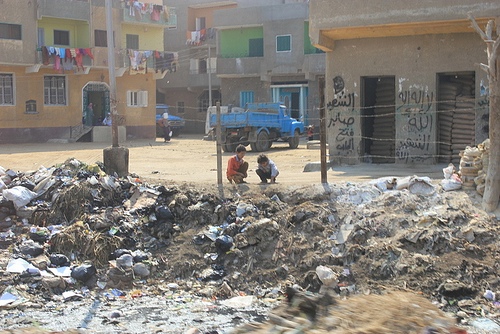 (AbuSir) – Photo of children playing near large mounds of toxic waste and trash strewn along the irrigation canal in Abu Sir that leads to the Nile. Before the revolution the government had started a clean up project but now that has been halted and with garbage pickup spotty at best, residents dump their garbage alongside it’s banks, sometimes even burning the rubbish to decrease the trash piles that block the flow of water to irrigate local crops. http://www.egyptindependent.com/news/garbage-piles-canals-residents-take-matters-their-own-hands
(AbuSir) – Photo of children playing near large mounds of toxic waste and trash strewn along the irrigation canal in Abu Sir that leads to the Nile. Before the revolution the government had started a clean up project but now that has been halted and with garbage pickup spotty at best, residents dump their garbage alongside it’s banks, sometimes even burning the rubbish to decrease the trash piles that block the flow of water to irrigate local crops. http://www.egyptindependent.com/news/garbage-piles-canals-residents-take-matters-their-own-hands
__________________________________________________________________________________________
Neglected mummy surrounded by trash in Luxor’s Assasif Mountain area, near the Valley of the Kings.
_________________________________________________________________________________________
I asked him about the recent reports of work by Sara Parcak, the University of Alabama archaeologist who, using satellite imagery, calculated the extent of the looting epidemic since the revolution, estimating an increase of 500 percent.
“The [looting] holes that Sarah Parcak is talking about,” Zahi responded, “are what looters leave behind and are not always accurate indicators of looting. These looters dig hundreds of exploratory holes and [they] are mostly failed attempts. They dig for two things — gold and the myth of the healing “red mercury” that supposedly exists in the throats of the mummies, which sometimes fetch high prices on the medicinal black market. There is no such liquid. I have never seen it. It doesn’t exist!”
While on the topic of Parcak’s work, I asked him how he felt about the merits of new technologies, such as the satellite imagery she used to make the recent headline-making new discoveries in Egypt.
“These technologies are all wonderful,” he responded, “but first of all, Egypt is filled with ancient sites – there are sites everywhere! The problem is these new technologies are incompatible with the current state of Egypt today. You find a site and it is reported but then who can we assign to protect it from looting and excavate it properly? There aren’t enough resources for the discovery of so many sites when the existing ones haven’t been properly secured and restored yet. You need a good and stable government for that!”
On another topic, much has been reported in the media regarding accusations and charges against Zahi for corruption related to contracts with National Geographic and the Discovery Channel. I inquired about them.
“All the charges have been dropped from lack of evidence of wrongdoing,” he explained. “I negotiated those projects based on what best offer of help they would provide for the benefit of Egypt. The National Geographic video was very successful for them and in return, the Egyptian Museum in Cairo received a 3 million dollar CT scan machine that is in use to this day and bringing to light many more insights and discoveries about the Pharaohs and their families. All funds paid by the Discovery Channel went straight to the Egyptian antiquities department. The Tutankhamun exhibit earned 125 million dollars for a new room inside the Grand Egyptian Museum in Giza, now under construction. These contracts were all approved beforehand by the Mubarak regime and were totally transparent.”
Egypt’s mega-project — its new Grand Egyptian Museum in Giza — promises to be Egypt’s crown jewel, just a mile away from the pyramids near Cairo. Giza’s skyline is dotted with so many cranes, it looks as if they are constructing a new pyramid. A large sign with red LED numbers in front of the site shows a countdown of 622 days. But this has been a running joke among the locals who say the countdown is in years, not days.
I asked him if he had any updates on the new museum.
“Construction work is ongoing, but very slow, as they need about 700 million dollars to complete the construction of this massive museum. With the current instability, who knows when that will be completed,” he lamented.
_________________________________________________________________________________________
Sunset sky filled with cranes looming over Giza Plateau almost a mile away from the pyramids complex. The cranes are being used to build the new Grand Egyptian Museum, which will be a much larger, state-of-the-art home for Egypt’s finest antiquities. The old museum will still be used but as more of a research center for Egyptology.
______________________________________________________________________________________________________________________
The construction coundtown clock at the building sight for the new Grand Egyptian Museum near Giza Plateau.
______________________________________________________________________________________________________________________
Zahi’s dream – to do the work that still needs to be done to complete his vision for the antiquities department – has been blocked. Looking to the future, that won’t stop him from making new discoveries and continuing to be an Egyptologist, he asserts. But for now, he is resigned to filling his days by organizing speaking tours in the U.S., and book signings in Geneva, Poland, and London, which began November 5th. He’ll be promoting his new book, Discovering Tutankhamun: From Howard Carter to DNA. He is also currently completing another book on the DNA research findings on the royal mummies at Cairo’s Museum of Egyptian Antiquities.
And his passion remains, not in carrying a title, but in being able to effect change and fulfill his personal mission as a guardian of Egypt’s heritage.
I asked him: “If it were offered to you again, would you want your old job back?
He answered with an emphatic “No!”
“Not in the current state Egypt is in. If there is no stability and Egypt is not brought back to a normal working condition, I would be useless and unable to perform my job well.”
I was curious to know what would be on his bucket list of future discoveries when and if life in Egypt returned to normal. He replied, without missing a beat:
“The tomb of Nefertiti, the tomb of the great Imhotep, and finally find the answer to what is behind Gantenbrink’s door inside the Great Pyramid. I believe Imhotep may be buried in an unexcavated area on the west side of the Step Pyramid at Saqqara. They have already found a 2nd Dynasty tomb underneath the Step Pyramid. Senenmut, the architect of Queen Hatshepsut at Deir el-Bahari, was buried near her mortuary temple there. This leads me to believe that Imhotep mirrored this same act of reverence near King Djoser’s Step Pyramid at Saqqara, since he was architect of that pyramid.”
Although not mentioned on his bucket list, Zahi addressed my additional inquiry about the status of the search for Cleopatra’s burial place.
“Dr. Kathleen Martinez unearthed a marble bust of Cleopatra and 22 coins with her image at a small cemetery inside the Ptolemaic temple at Taposiris Magna in Alexandria, some time ago. Unfortunately, that mystery still remains unsolved after more than 5 years of digging and the excavations at the site are ongoing with Dr. Martinez.”
Finally, at the risk of getting a bit too political in a country where the current sensitivities in this realm run high, I asked the big question: “Who would you like to see as the next president?”
There was little hesitation in his response, but his discretion was clear.
“Whoever the people elect, that leader must be very strong and determined to make changes quickly. There are so many people that haven’t worked in three years. The situation is terrible.”
Meanwhile, Zahi is enjoying the legacy he has already built. Next stop: a flight to another speaking engagement and book signing……….to a country where “revolution” is something one only reads about happening somewhere else.
__________________________________________________________________________________________
Zahi Hawass with long time friend and fellow Egyptologist, Mary Lomando at his home office in Cairo.
____________________________________________________________________________________________
Article Supplement
A COUNTRY IN CRISIS
The Egypt of today is a surreal dichotomy. Its once remarkably rich and powerful civilization led by vibrant pharaohs contrasts sharply with the economic and political breakdown of the seemingly leaderless Egypt of today. At present, Egypt’s unemployment rate is over 13 percent (locals say it’s much higher). Moreover, like other third-world countries, much of its population lives in poverty, while luxurious havens exist for the elite few in Cairo, Alexandria, Hurghada, and Sharm el-Sheikh. Income inequality and corruption are as bad as, if not worse than, most other third-world countries.
On our way to visit the pyramids at Giza, youth—no more than 13 years of age— suddenly surrounded the taxi driving us down the old Pyramids Road. They tapped on the car’s windows in an attempt to get money, or baksheesh, from us. Our driver exclaimed apologetically, “They are starving!” in a spurt of honesty that was so heartfelt, it rang in my ears, creating instant empathy for their living conditions. Being Cuban, and having visited my country several times, parallels were instantly drawn in my mind of how far a failed government can effect it’s own people, forcing them to be capable of anything in an effort to survive.
Yet, even though Egypt’s people are in dire need, the country is very safe to visit. Tourists are always treated with kindness and appreciation. It’s an unspoken rule to treat tourists well, but every now and then you will get a character that won’t take “No, thank you” for an answer. A payment of baksheesh—about 10 Egyptian pounds ($1.44 US)—usually satisfies them. Egypt’s economy is heavily reliant on tourism, and the revolution has taken a toll on the tourism industry, which, since the revolution erupted in 2011, has come to a virtual standstill. It would not be an exaggeration to say that at many of the sites we visited we were the only American tourists around. Whenever we were asked the common question: “Where are you from?” our response was always greeted with “Ah, America . . . good people!” Thankfully, Tourism Minister Hisham Zazou announced on October 2, 2013, that 13 countries have now lifted bans on travel to Egypt. The latest two countries, Austria and Ireland, lifted bans to holiday destinations in the Red Sea and South Sinai.
But despite some silver linings, Egypt remains in the grips of an ongoing revolution, and the resultant consequences for its archaeological treasures have been grim. Egypt’s Malawi National Museum was looted and vandalized in August of 2013 by local Muslim extremists, and many artifacts, even wooden sarcophagi, were hacked to pieces with axes. Reports of looting have been leaked from independent sources, but as yet there isn’t much actual data, or an official account, of what has gone missing. However, in Jerusalem, a public auction of 126 recently looted antiquities was halted, evidence that many antiquities are being smuggled out through Egypt’s porous borders.
Mary Lomando and I visited Saqqara and the Abu Sir pyramids area the day before meeting with Dr. Hawass, and reported to him that the replica, full-size statue of King Djoser sitting inside his serdab enclosure was moved out of line in a failed looting attempt. Most looters are not educated enough to know it is a replica. The representation of the ancient king now sits in wait, no longer aligned, blocked from his line of sight to the stars. It is a standing metaphor for the state of Egypt today.
—- EV
_________________________________________________________________________________________
Djoser’s serdab with eyesight holes.
_________________________________________________________________________________________
Before the attempted looting: The pharaoh Djoser’s statue looks out through the hole in his serdab. Wikimedia Commons
_______________________________________________________________________________________________________________________
After: The position of the statue as shifted due to the looting attempt.
__________________________________________________________
Cover Photo, Top Left: View of the great pyramids at Giza. by Soupysquirrel, Pixabay
______________________________________________

